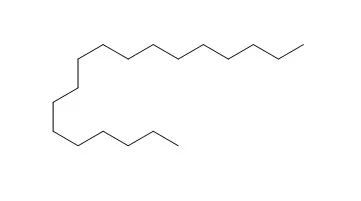| Appl Environ Microbiol . 1992 Oct;58(10):3276-3282. |
| Enhanced octadecane dispersion and biodegradation by a Pseudomonas rhamnolipid surfactant (biosurfactant)[Pubmed: 1444363] |
| A microbial surfactant (biosurfactant) was investigated for its potential to enhance bioavailability and, hence, the biodegradation of octadecane. The rhamnolipid biosurfactant used in this study was extracted from culture supernatants after growth of Pseudomonas aeruginosa ATCC 9027 in phosphate-limited proteose peptone-glucose-ammonium salts medium. Dispersion of octadecane in aqueous solutions was dramatically enhanced by 300 mg of the rhamnolipid biosurfactant per liter, increasing by a factor of more than 4 orders of magnitude, from 0.009 to > 250 mg/liter. The relative enhancement of octadecane dispersion was much greater at low rhamnolipid concentrations than at high concentrations. Rhamnolipid-enhanced octadecane dispersion was found to be dependent on pH and shaking speed. Biodegradation experiments done with an initial octadecane concentration of 1,500 mg/liter showed that 20% of the octadecane was mineralized in 84 h in the presence of 300 mg of rhamnolipid per liter, compared with only 5% octadecane mineralization when no surfactant was present. These results indicate that rhamnolipids may have potential for facilitating the bioremediation of sites contaminated with hydrocarbons having limited water solubility. |
| Polymers (Basel) . 2020 Sep 28;12(10):2226. |
| Bifunctional Microcapsules with n-Octadecane/Thyme Oil Core and Polyurea Shell for High-Efficiency Thermal Energy Storage and Antibiosis[Pubmed: 32998274] |
| A new kind of bifunctional microcapsule containing a n-Octadecane (OD) and thyme oil (TO) core based on polyurea shell designed for thermal energy storage and antibiosis was prepared successfully through interfacial polymerization. The scanning electron microscopic investigations reveal that the obtained composite microcapsules present the regular spherical morphology and the transmission electron microscopic observations confirm the clear core-shell structure. Morphological and chemical structure analyses prove the successful synthesis of bifunctional microcapsules. Thermogravimetric analysis indicates that the polyurea shell can protect the composite cores effectively. Differential scanning calorimetry examination shows that the bifunctional microcapsules can maintain high thermal storage capacity and the encapsulation efficiency of OD increases with the increase in TO. The supercooling crystallization can be notably suppressed by adding 7 wt.% of n-octadecanol. A study on the release behavior of TO from the bifunctional microcapsules reveals that the Higuchi kinetic model could better fit the TO release profile. The antibacterial results demonstrate that the bifunctional microcapsules can effectively inhibit the growth of Staphylococcus aureus and the inhibition rate can reach as high as 99.9% when the mass concentration of microcapsules is over 3 wt.%. |
| J Microbiol . 2013 Dec;51(6):791-799 |
| Trans-membrane transport of n-octadecane by Pseudomonas sp. DG17[Pubmed: 24385357] |
| The trans-membrane transport of hydrocarbons is an important and complex aspect of the process of biodegradation of hydrocarbons by microorganisms. The mechanism of transport of (14)C n-Octadecane by Pseudomonas sp. DG17, an alkane-degrading bacterium, was studied by the addition of ATP inhibitors and different substrate concentrations. When the concentration of n-Octadecane was higher than 4.54 μmol/L, the transport of (14)C n-Octadecane was driven by a facilitated passive mechanism following the intra/extra substrate concentration gradient. However, when the cells were grown with a low concentration of the substrate, the cellular accumulation of n-Octadecane, an energy-dependent process, was dramatically decreased by the presence of ATP inhibitors, and n-Octadecane accumulation continually increased against its concentration gradient. Furthermore, the presence of non-labeled alkanes blocked (14)C n-Octadecane transport only in the induced cells, and the trans-membrane transport of n-Octadecane was specific with an apparent dissociation constant K t of 11.27 μmol/L and V max of 0.96 μmol/min/mg protein. The results indicated that the trans-membrane transport of n-Octadecane by Pseudomonas sp. DG17 was related to the substrate concentration and ATP. |
| PLoS One . 2017 Jun 29;12(6):e0179842. |
| Quantitative proteomics analysis of proteins involved in alkane uptake comparing the profiling of Pseudomonas aeruginosa SJTD-1 in response to n-octadecane and n-hexadecane[Pubmed: 28662172] |
| While many data are available on genes encoding proteins for degradation of hydrocarbons in bacteria, the impact of alkane on transporter protein expression is unclear. Pseudomonas aeruginosa SJTD-1 is a strain that can consume medium- and long-chain n-alkanes. In order to study the proteins involved in n-Octadecane uptake, we use iTRAQ and label free comparative proteomics analysis to identify the proteins of alkane uptake in response to n-Octadecane (C18) comparing with n-hexadecane (C16) in P. aeruginosa SJTD-1. A total of 1102 and 1249 proteins were identified by iTRAQ-based and label free quantitative methodologies, respectively. By application of 1.5 (iTRAQ) or 2-fold (label free) for upregulated and 0.65 (iTRAQ) or 0.5-fold (label free) for downregulated cutoff values, 91 and 99 proteins were found to be differentially expressed comparing SJTD-1 cultivated on C18 with C16 respectively. There are six proteins with the common differential expression by iTRAQ and label free-based methods. Results of bioinformational analysis suggested the involvement of bacterial chemotaxis in responds to C18. Additionally, quantitative reverse transcriptase PCR (qRT-PCR) results confirmed C18-induced change in levels of FleQ, FliC, NirS, FadL and FadD proteins and the role of the proteins in n-Octadecane uptake was further discussed in P. aeruginosa. In conclusion, results of the present study provided information about possible target-related proteins of bacterial chemotaxis, swimming performance, alkane transport to stimulus of n-ctadecane rather than n-hexadecane in P. aeruginosa SJTD-1. |






 Cell. 2018 Jan 11;172(1-2):249-261.e12. doi: 10.1016/j.cell.2017.12.019.IF=36.216(2019)
Cell. 2018 Jan 11;172(1-2):249-261.e12. doi: 10.1016/j.cell.2017.12.019.IF=36.216(2019) Cell Metab. 2020 Mar 3;31(3):534-548.e5. doi: 10.1016/j.cmet.2020.01.002.IF=22.415(2019)
Cell Metab. 2020 Mar 3;31(3):534-548.e5. doi: 10.1016/j.cmet.2020.01.002.IF=22.415(2019) Mol Cell. 2017 Nov 16;68(4):673-685.e6. doi: 10.1016/j.molcel.2017.10.022.IF=14.548(2019)
Mol Cell. 2017 Nov 16;68(4):673-685.e6. doi: 10.1016/j.molcel.2017.10.022.IF=14.548(2019)